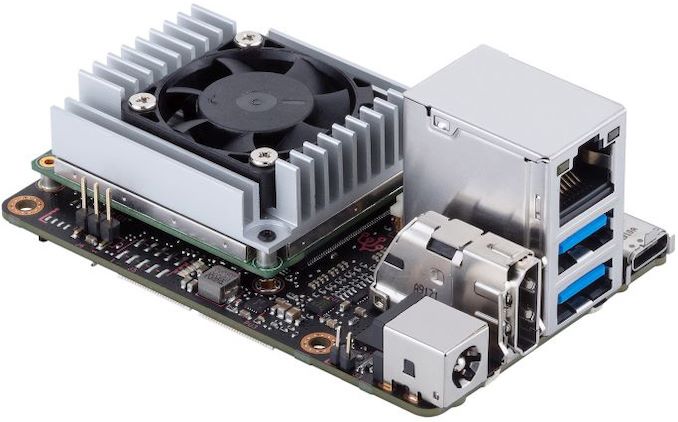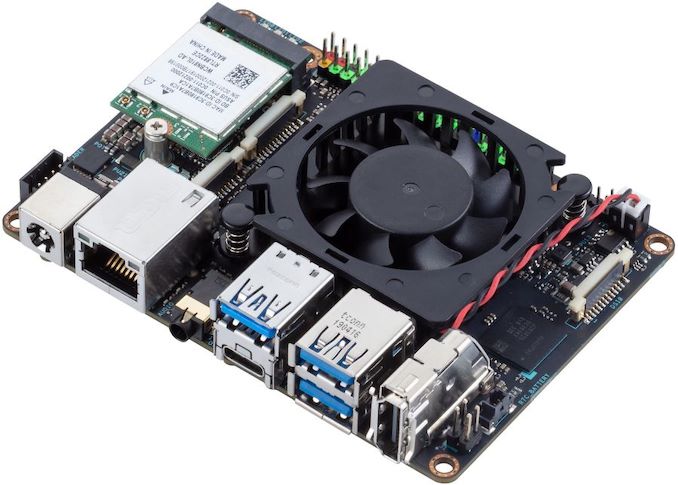ASUS & Google Team Up for ‘Tinker Board’ AI-Focused Credit-Card Sized Computers
by Anton Shilov on November 12, 2019 5:00 PM EST- Posted in
- AI
- Asus
- Tinker Board

ASUS and Google have joined forces to develop a new project that the companies are calling ‘Tinker Board’ single board computers (SBCs). With a footprint not much larger than a credit card, the systems are designed for building small systems to work on AI inference applications like image recognition.
The systems in question are the Tinker Edge T and Tinker Edge R. The former is based on the NXP i.MX8M with an Edge TPU chip that accelerates TensorFlow Lite, whereas the Tinker Edge R is powered by the Rockchip RK3399 Pro processor with an NPU for 4K machine learning. The SBCs officially support Android and Debian operating system, though nothing prevents them from running Linux or other OSes.
Both Tinker Edge T and Tinker Edge R computers feature active cooling as well as mainstream I/O interfaces, including GbE, USB 3.0, and HDMI.
ASUS and Google position their Tinker Edge T and Tinker Edge R for various edge AI applications that have to be compact and very energy efficient.
ASUS plans to demonstrate its Tinker Edge T and Tinker Edge R SBCs at the IoT Technology 2019 conference in Japan, which kicks off on November 20. Pricing of the devices remains to be seen, but it will depend on volumes and other factors.
Related Reading:












38 Comments
View All Comments
Death666Angel - Wednesday, November 13, 2019 - link
That is an interesting questions. Considering the amount of pins it has (24) it seems quite unlikely. I haven't even seens a double stacked USB C implementation, yet.willis936 - Wednesday, November 13, 2019 - link
tbh I don’t like the direction raspis are going. They’re getting bigger and using more power. I want the smallest, cheapest linux box possible. To that end the raspi 0 is my go to. It’s slow though. My hope is that in a few years when there are nice process shrinks cheaply available they’ll move to a more power efficient/powerful processor in the raspi 0. All the bells and whistles aren’t terribly important for physical nodes given simple tasks.notashill - Wednesday, November 13, 2019 - link
Sounds like you would like the Banana Pi M2 Zero or Orange Pi Zero, they have quad core A7s like the Pi 2 but the banana is in the Pi 0 form factor for $20 and the orange is a ~50mm square for $10.nandnandnand - Wednesday, November 13, 2019 - link
Compare the Pi3 with the Pi4. The node shrank from 40nm to 28nm, which helped efficiency, but it switched from efficiency-oriented Cortex-A53 to performance-oriented Cortex-A72. There will never be a switch like that again. If they switch to A75 or newer, they are remaining in the same lane, but with increasing performance/Watt. They could prioritize higher clocks but I doubt the power consumption will increase. Unless they go from quad-core to 6 or 8 cores...mode_13h - Friday, November 15, 2019 - link
I predict the Pi 5 will keep 4x A72 (or maybe switch to A73) cores and mainly focus on GPU/machine learning perf. Even the Pi 4 is seriously weak, in the GPU department. Still, cost constraints will keep them from being truly competitive with SoCs built on a much smaller manufacturing node.nandnandnand - Friday, November 15, 2019 - link
I saw chatter on the Pi forums that suggested the VideoCore VI was here to stay. Possibly no changes to the GPU whatsoever for years. I don't know how much can be believed over there given the tight lipped team and the misleading comments made about the Pi4 coming in 2020, etc. Like you, I expected some focus on ML with Pi4 given the educational focus and ML is Big Right Now. Maybe even Google subsidized hardware. Instead, Google has set out on their own.I expect something better than a switch to 4x A73 since if you look at Pi1 -> Pi2 -> Pi3 -> Pi4, you see significant jumps in CPU performance. If it's not +50%, there's no point. They also seem to have indicated that Pi4 will be around for a while, so maybe no Pi5 until 2022? A75 seems like the way to go and it is being fabbed on 28nm: https://en.wikipedia.org/wiki/Comparison_of_ARMv8-...
For Pi6, I'll predict a 6-core CPU on a 14nm node. In 2024.
In the further future, they should use 3DSoC. That could make many desktops obsolete.
mode_13h - Saturday, November 16, 2019 - link
You're forgetting about things like cost & power. The reason I think they'll stay on A72 or A73 is that those are fast enough, for the time being, and that anything appreciably faster would probably burn a lot more die space, if not also more power.Right now, the Pi is hurting for GPU performance, for the sake of GPU compute applications & deep learning. So, that's where I expect they'll spend any additional transistor budget.
mode_13h - Friday, November 15, 2019 - link
Cheap, fast, and low power? Pick any 2.Pi is focused on the $35 price point, to a fault. They've already said they expect to stay on the current 28 nm process node, for the next couple generations. So, don't expect them to get much faster or more power-efficient.
I'd suggest the ODROID N2, which is made on a 12 nm manufacturing process, and has correspondingly better power efficiency, as a result. You'll pay for it, though.
johnnycanadian - Tuesday, November 12, 2019 - link
The R sounds damn cool until you check out a similar product based on the same SoC:https://store.vamrs.com/products/tb-rk3399pro-rock...
Hmmm. A bit dear for a tinker board.
p1esk - Wednesday, November 13, 2019 - link
$300 is not too bad. If I wanted to tinker with machine learning hardware, I’d rather use a chip with decent performance. Unless there are better and cheaper products?